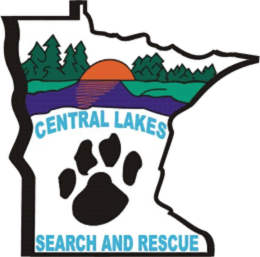Central Lakes Search and Rescue Standards
Basic Operational Member (Field Tech) Requirements.
The following requirements apply to all new members of CLSAR and must be completed before a member will receive operational status.
ICS/NIMS:
- IS-005 Introduction to Hazardous Materials
- IS-100 Intro to ICS
- IS-200 ICS for Single Resources & Initial Action Incidents
- IS-700 National Incident Management System (NIMS), an Introduction
- IS-800 National Response Framework, an Introduction
Search Management
- 8 hours participation in mock searches
- 4 hours participation in command function in mock searches
- CLSAR approved Search Management Class
- 4 hours observation on an actual CLSAR mission
Medical:
- Basic First Aid Certificate course
- American Heart Association or Red Cross CPR w/AED
- K-9 First aid with CPR
Navigation:
- Map and Compass – table top / field exercises
- GPS – settings and use
Communications:
- Radio – set up and use (base and in the field)
- 4 hours base radio at a mock search
Survival:
- Cold weather overnight bivouac
- Build an improvised shelter
- Start a fire w/o use of matches or lighter
- Proper use of signal mirror
Physical Fitness:
- Complete 3 mile hike w/full pack
- Lift 50 pound object onto/off an elevated platform
- Carry a 200 pound load 50 feet with assistance
Records:
- Canine Training / Certification Log (if applicable)
- Personal Training log
- Personal / Canine Emergency file
Miscellaneous Skills:
- Mantracking
- Ropes and knots
Basic Canine Requirements.
The following requirements apply to all canine members of CLSAR and must be completed before a handler/canine team will receive operational status. Discipline-specific requirements not listed here are also required.
Obedience/Behavior:
- AKC Canine Good Citizen or equivalent
- Crowded Vehicle – The dog and handler will load into the back of a vehicle, such as a pickup truck, along with at least two other people and two other dogs. The vehicle will then be driven for a distance of at least one mile during which time the dog must not display aggressive or uncontrolled behavior.
- Canine Walk-By: The dog will be tied to a stationary point on a 6-foot lead. Another handler, with a dog at heel, will walk within 10 feet of the point where the dog is tied. The dog will show no aggressive behavior.
- Sit, Down, Stay: The dog will remain in place (sitting or in a down) without correction for a minimum of five minutes with the handler a minimum of 50 feet away. The dog will remain in place even if people or other dogs are present and moving around the dog. The dog will not be tied.
- Emergency stop: The handler must be able to stop the dog while it is in motion.
Agility:
- Jump: The dog will jump onto an object, such as the tailgate of a pickup truck or an elevated platform, having a minimum height of 2.5 feet.
- Traverse: The dog will walk across a board that is at least 12 feet long, no more than 12 inches wide, and is at least 3 feet above the ground.
- Tunnel: The dog will go through a 36″ diameter passageway at least 8 feet long.
Unique situations:
- Stream/Pond Crossing: Demonstrate the ability to cross a stream or pond safely under voice command.
- ATV: Calmly and quietly ride in/on an ATV or similar vehicle with assistance of handler.
- Aircraft: Calmly and quietly ride in an aircraft with handler (this is not a requirement, done only if available).
- Watercraft: Calmly and quietly ride in a watercraft with handler.
- Animals: Demonstrate the ability to work around livestock and/or other animals.
Final Trained Response:
- Demonstrate a known audible/physical/visual indication of the find (final trained response). Handler should be able to describe indication.
